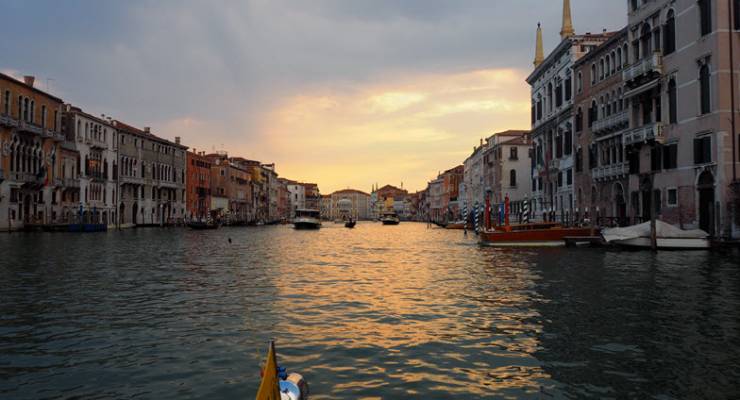
The art world was abuzz this week with the announcement that the Australia Council is reforming the selection process for Australia’s representation at the Venice Biennale.
Australia’s presence at the world’s most prestigious art fair is funded through a mix of public and private support. The federal government chips in funding through the Australia Council, but donors and philanthropists like fashion mogul Naomi Milgrom and merchant banker Simon Mordant – current and former “independent commissioners” to Venice – also dig into their own pockets to help.
But that’s all changed with the Australia Council’s decision to bring the process in-house. Instead of an independent commissioner choosing who gets to be Australia’s art star at Venice, the Australia Council will call for submissions. A board of reviewers headed up by artist and academic Callum Morton will choose.
The well-heeled types who frequent exclusive vernissages are not pleased. The decision was heavily criticised by Mordant and fellow philanthropist Hamish Balnaves, who phoned up Fairfax Media arts journalist Andrew Taylor to complain.
“I am completely and utterly speechless,” one unnamed art world figure told Fairfax’s Andrew Taylor. “If a CEO of any arts organisation behaves the way towards donors the way they have behaved, they would be fired.” Mordant was also aggrieved, reportedly writing to the Australia Council’s CEO Tony Grybowski to complain.
By Wednesday, both Mordant and Hamish Balnaves of the Balnaves Foundation had pulled their funding from Australia’s Venice presence. According to Taylor, Balnaves even claimed he had lost confidence in the leadership of Australia Council chief executive Tony Grybowski and chairman Rupert Myer.
So what are the millionaires so upset about? In a word: control.
The previous arrangements, where an independent commissioner chaired a panel of five art world bosses, was opaque and closed. Artists could not apply, and the choices made favoured a small group of influential gallerists, led by Anna Schwartz and Rosyln Oxley.
The interlinked interests of top curators, donors and galleries is an open secret in Australia’s art world. Artists represented by Oxley have filled three of the past four solo slots at Venice. The panel that chose this year’s artist Tracey Moffat is also a coterie of friends and former colleagues centered on current commissioner Milgrom.
As Daily Review’s John Kelly pointed out in a Walkley-nominated essay this year, one of the Venice panelists, Rebecca Coates, did her PhD on the public art company run by Milgrom’s husband, John Kaldor (himself a former commissioner). The tight circle around Oxley and Mordant in Sydney has been just as influential, with Oxley-represented artists travelling to Venice in the same years that Mordant was commissioner.
The new arrangements will do away with such cosy networks, and make Australia’s representation at Venice a much more open and transparent process.
The irony of the controversy is that the change was forced on the Australia Council by the Venice Biennale itself, which has mandated that all national pavilions must be managed and run by their national cultural agency – in Australia’s case, the Australia Council. La Biennale di Venezia has bluntly told participating countries that “the Commissioner will have to belong to the Governmental Authority or to the delegated Public Institution representing the Country”. The reason given is explicitly stated as “transparency”.
According to Australia Council chairman Myer, the changes represent an important reform.
“The Australia Council way of doing things is one that provides transparency and robust contestability and peer review,” he told Crikey by phone. “The change is broadly a governance change, and that’s the change that the Biennale itself has driven.”
Myer argues that after two decades of a closed shop, the open call out will allow for a much more diverse range of artists to get a look in. “Last year the Australia Council dealt with 10,000 submissions,” he said. “Clearly one of the core competencies of the Council is in the peer review of projects that come our way.”
Myer refused to be drawn on the criticisms from Mordant and Balnaves, observing drily that “the Australia Council has never suffered from lack of advice”. He also told Crikey that the Australia Council was well progressed in bringing in donations to replace the money withdrawn.
Outside the echo chamber of aggrieved philanthropists, reaction to the changes has been positive. The National Association for the Visual Arts’ Esther Anatolitis told Crikey that “the Venice Biennales exist to set an international cultural agenda”, and that, as a result of the reforms, “Australian artists will now lead that agenda”.
Anatolitis says philanthropists should embrace the new system. “That’s what drives philanthropists: to be indispensable to the development of creative ambitions, to make the impossible possible, and to foster artistic audacity.”








This is good news and a much more informative article than the gossipy sour grapes from John Kelly in the Daily Review. The pulling of funding from Mordant and Balnaves just demonstrates that they’re not real philanthropists, only wealthy people seeking to buy power.